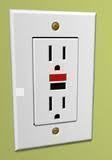What is a GFCI Outlet?
GFCI outlets give people additional protection from electrical shock. They also reduce the risk of structure or house fires that electrical system faults cause and mitigate the risk that faulty electrical circuits pose to equipment. A ground fault circuit interrupter is used in a GFCI outlet in order to cut electrical power when a fault is detected. It may also be installed at a breaker box or used as a portable outlet.
How does a GFCI Outlet Work?
A GFCI outlet monitors the flow of current through the outlet’s circuit. If an imbalance arises between the hot and ground poles in the GFCI outlet indicating a ground fault, the circuit trips, thereby protecting the equipment connected to the outlet. A number of causes, including electrical devices coming into significant contact with water, a person touching an energized circuit, or faulty electrical wiring can create ground faults. A GFCI outlet has a “test” and “reset” button at the outlet’s front-end. It can be tested by plugging an electrical device into the outlet and pressing the “Test” button, which temporarily interrupts the circuit and the reset button pops out. When the “reset” button is pressed, the circuit is restored.
Are GFCI Outlets Required?
In many parts of the developed world, the law requires GFCI outlets in designated locations such as kitchens, bathrooms, garages, outdoor outlets, crawl spaces, and unfinished basements. Although they are useful in other locations, they are required in areas where equipment that draw a large amount of current or may be exposed to water are in order to increase safety. GFCI outlets can be installed in most outlet locations throughout a home or other structure that otherwise meet the required electrical code.
What to do if a GFCI Outlet is Tripped
When a GFCI outlet is tripped, the reason for the electrical fault should be assessed before resetting the circuit to avoid damage to household equipment. Although the electrical fault’s source could be a temporary fault in the circuit, significant damage can result if there is a major ground fault. Additionally, electrical shock can occur if a GFCI outlet that has tripped due to a major fault in the home’s electrical system is touched. Electricians can run diagnostic tests on a tripped GFCI circuit in order to ascertain the reason and to determine the actions required to troubleshoot the problem.


Comments - One Response to “What is a GFCI Outlet?”
Sorry but comments are closed at this time.